OEIS/FASS curves: Difference between revisions
imported>Gfis No edit summary |
imported>Gfis Start/end opposite corners |
||
| Line 87: | Line 87: | ||
A brute-force, backtracking algorithm which generates all pathes for a specific base runs rather fast up to base 5 (412 possible paths). For base 7, there are about 3 millions of paths starting with 00~01 ("~" denotes "adjacent to"), but only 47 of them can be continued in dimensions > 2. For base 9, the brute-force approach is not feasible, and it is necessary to develop restrictions for the backtracking algorithm. | A brute-force, backtracking algorithm which generates all pathes for a specific base runs rather fast up to base 5 (412 possible paths). For base 7, there are about 3 millions of paths starting with 00~01 ("~" denotes "adjacent to"), but only 47 of them can be continued in dimensions > 2. For base 9, the brute-force approach is not feasible, and it is necessary to develop restrictions for the backtracking algorithm. | ||
For this discussion, let digits b = base-1, a = b-1, c=b+1, h=a/2, and for elements | For this discussion, let digits b = base-1, a = b-1, c=b+1, h=a/2, and for elements (n, n) on the diagonal, m=n-1, p=n+1. For a node, we will write xy instead of (x,y), and zxy instead of (z,x,y). hh is the ''center'' element, {00, 0b, bb, b0} is the set of ''corner'' elements. Let st be the coordinates of the start point, and ef those of the end point. | ||
0b 1b .. ab bb .. .. .. .. .. | 0b 1b .. ab bb .. .. .. .. .. | ||
| Line 97: | Line 97: | ||
00 10 .. a0 b0 .. .. .. .. .. | 00 10 .. a0 b0 .. .. .. .. .. | ||
==== | The path must visit every node in the square of the adjacency matrix exactly once, and so it must in the d-dimensional cubes (for d >= 3) of edge length ''base''. Furthermore, any projection of such a cube to the plane must show the same adjacency matrix (for odd bases; even bases are discussed later). In essence, any projection must not show some "T" pattern: | ||
The start point starts the multidimensional path, and the end point is the last path element in the square, 2-dimensional adjacency matrix. | mn==nn==pn mp | ||
|| || | |||
nm or mn==nn | |||
|| | |||
mm | |||
====Start and end points in some corner==== | |||
The start point starts the multidimensional path, and the end point is the last path element in the square, 2-dimensional adjacency matrix. At the end point, the path continues into the 3rd dimension (z=1), It is natural to assume a start point 00, and experiments show that the end point then always is the opposite corner bb for continuing paths. BTW, there are continuing paths which are not rotational symmetric (e.g. Ls and Ln for base 5). | |||
* The start and the end point both are corner elements. | |||
Otherwise, they will show a "T" pattern in one of the projections zx, zy. | |||
* Start and end point are in opposite corners. | |||
====Normalization 00~01==== | ====Normalization 00~01==== | ||
* We may always start with 00~01. | |||
There are 7 equivalent paths starting with 00~10, 0b~0a, 0b~1b, bb~ab, bb~ba, b0~1b, b0~a0. Therefore only one set needs to be computed. | |||
====Conflicts on the diagonal==== | ====Conflicts on the diagonal==== | ||
If 0n~1n, and if nn is not the endpoint, then any of the 4 possible neighbours of nn leads to a conflict: | |||
* ''west'' | * ''west'' mn~nn leads to conflict (0mn~0nn, 0nn~1nn) | ||
* ''south'' | * ''south'' nm~nn leads to conflict (0nm~0nn, 0nn~1nn) | ||
* ''east'' | * ''east'' pn~nn leads to conflict (0pn~0nn, 0nn~1nn) | ||
* ''north'' | * ''north'' np~nn leads to conflict (0np~0nn, 0nn~1nn) | ||
The Perl program <code>[https://github.com/gfis/fasces/blob/master/data/gen_paths.pl gen_paths.pl]</code> uses the following considerations. | The Perl program <code>[https://github.com/gfis/fasces/blob/master/data/gen_paths.pl gen_paths.pl]</code> uses the following considerations. | ||
and since , and for therefore always 0xy~1xy, which implies 0x~1x and 0y~1y. Assume that both the start and the end point are no corners. This implies 01~00~10, 0a~0b~1b, ab~bb~ba, and b1~b0~a0. | |||
A path is said to be ''continuing'' if it can be continued by the adjacency matrix rule into all (many) dimensions. | |||
Revision as of 16:32, 22 May 2018
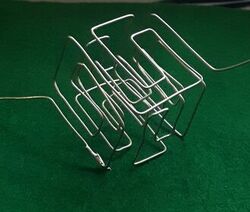
Beyond OEIS sequence A220952
After my initial attemps to extend sequence A220952 I became interested in FASS curves in general.
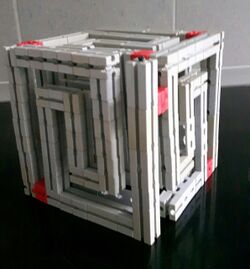
Sequence A220952 is best discussed with numbers to base 5. The first 125 values then are:
0, 1,2,3,4, 14,24,34,33,32,31,21,22,23,13,12,11,10,20,30,40,41,42,43,44, 144,244,344,343,342,341,241,242,243,143,142,141,140,240,340, 330,320,310,210,220,230,130,120,110,111,112,113,123,122,121, 131,132,133,233,232,231,221,222,223,213,212,211,311,312,313, 323,322,321,331,332,333,334,324,314,214,224,234,134,124,114, 104,204,304,303,302,301,201,202,203,103,102,101,100,200,300, 400,401,402,403,404,414,424,434,433,432,431,421,422,423,413, 412,411,410,420,430,440,441,442,443,444
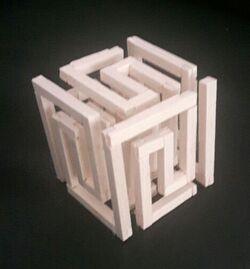
In each generation the number of digits is increased by one. The first 25 values form the adjacency condition matrix as defined by Knuth:
Kn 04==14==24==34 44 || || || 03 13==23 33 43 || || || || || 02 12 22 32 42 || || || || || 01 11 21==31 41 || || || 00 10==20==30==40
Here, the last digit is the y coordinate, and the digit before is the x coordinate. In generation 3, the left-most digit can be interpreted as the z coordinate. Since this is Knuth's original adjacency matrix, and since it shows a path similiar to a letter n inside the square, I named it "Kn".
The curve is space-filling in every dimension
For the cube I wrote a Javascript program with the beautiful framework three.js.
A Go package for Hilbert and Peano curves can be found on github.com.
Variants
Next I wrote a Perl program which always starts with nodes 00, 01, but which then exhausts all possible paths which fill the 5*5 square. That program found several adjacency matrices which have similiar properties like that of Knuth. Depending the shapes of the paths, I invented names for them:
Fs Ls Ln NN 04==14==24==34 44 04==14 24==34==44 04==14 24==34 44 04==14 24==34 44 || || || || || || || || || || || || || || || || 03 13==23==33 43 03 13 23==33==43 03 13 23 33 43 03 13 23 33 43 || || || || || || || || || || || || || || || || 02 12==22==32 42 02 12 22==32==42 02 12 22 32==42 02 12 22 32 42 || || || || || || || || || || || || || || 01 11==21==31 41 01 11 21==31==41 01 11 21==31==41 01 11 21 31 41 || || || || || || || || || || || || || || 00 10==20==30==40 00 10==20==30==40 00 10==20==30==40 00 10==20 30==40
For these 4 matrices I checked the uniqueness of the generated paths up to n=3125 (5th dimension). Proofs similiar to that for sequence A220952 can probably be devised for these matrices, too.
You may look at:
- "Fs" as a colored line with coordinates
- "Fs" as a solid 3D model
- more examples, also for bases 2..7
Different Bases
Searching for space filling paths reminds me a bit to the famous OEIS stamp folding sequence A001011. The Perl program mentioned above finds following numbers of space filling matrices for bases 1, 2, 3 ...;
base count examples and notes
1 1 (a single node)
2 1 01==11 first order Hilbert curve
|| ||
00 10
3 4 02==12==22 02==12==22 02==12==22 02==12 22
|| || || || || || || ||
01==11 21 01 11==21 01 11 21 01 11 21
|| || || || || || || || || || ||
00 10==20 00 10==20 00 10==20 00 10==20
4 26
5 412 where 5 generate paths up to the 5th dimension
6 11072
... ?
The basic building block (for odd bases) seems to be the last matrix for base 3 above. Only this one generates a path (up to the 6th dimension).
3D Manufacturing
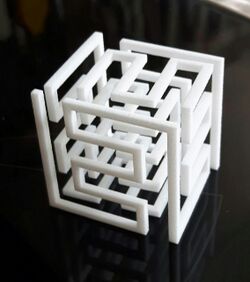
All my attempts to physically build such objects were unsatisfying so far. The balsa lumber and the Fischertechnik (above) approaches worked somehow, but both needed distance bars (thin needles for the balsa, red blocks for Fischertechnik) to keep the geometry in shape. Cutting and glueing the 62 balsa parts was very tedious.
In discussions with several people I learned that such FASS curves cannot be produced by conventional processes like milling or die casting. Therefore I tried the current hype of 3D printing.
With Three.js it is also very easy to store an STL file derived from the virtual scene. STL is the main format for stereolithography CAD software, 3D printers and other manufacturing devices. STL stores a mesh, that is a set of triangles representing the geometry of the object.
- Download the meander STL file and view it with the free service of viewstl.com, and/or
- send the STL file to the production service company of your choice.
During my holidays in Greece I sent this a file to trinckle.com in Germany, and within 10 days and 20 € I received the nice 4x4 cm cube on the right. It was made by sintering plastic (polyamide) with a laser. The problem is that the structure cannot be built on a supporting surface, and that there is some warping caused by the heat of the laser and the weight of the material. The object is very fragile.
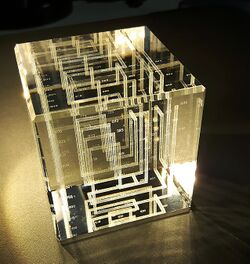
In the next step I ordered a 5x5x5 cm bubblegram, an internally engraved glass cube from easycrystal.de for about 40 €. Such a cube is very stable, and the engraved point cloud for the FASS curve is geometrically exact. In addition to the curve the base 5 coordinates are shown, but they are very tiny. The STL file should probably be "cleaned" from triangles inside the bars. There is a good overview of 7 free STL editors, among them MeshMixer.
Observations and efficiency considerations
A brute-force, backtracking algorithm which generates all pathes for a specific base runs rather fast up to base 5 (412 possible paths). For base 7, there are about 3 millions of paths starting with 00~01 ("~" denotes "adjacent to"), but only 47 of them can be continued in dimensions > 2. For base 9, the brute-force approach is not feasible, and it is necessary to develop restrictions for the backtracking algorithm.
For this discussion, let digits b = base-1, a = b-1, c=b+1, h=a/2, and for elements (n, n) on the diagonal, m=n-1, p=n+1. For a node, we will write xy instead of (x,y), and zxy instead of (z,x,y). hh is the center element, {00, 0b, bb, b0} is the set of corner elements. Let st be the coordinates of the start point, and ef those of the end point.
0b 1b .. ab bb .. .. .. .. ..
0a 1a .. aa ba .. mp np pp ..
.. .. hh .. .. .. mn nn pn ..
01 11 .. a1 b1 .. mm nm pm ..
00 10 .. a0 b0 .. .. .. .. ..
The path must visit every node in the square of the adjacency matrix exactly once, and so it must in the d-dimensional cubes (for d >= 3) of edge length base. Furthermore, any projection of such a cube to the plane must show the same adjacency matrix (for odd bases; even bases are discussed later). In essence, any projection must not show some "T" pattern:
mn==nn==pn mp
|| ||
nm or mn==nn
||
mm
Start and end points in some corner
The start point starts the multidimensional path, and the end point is the last path element in the square, 2-dimensional adjacency matrix. At the end point, the path continues into the 3rd dimension (z=1), It is natural to assume a start point 00, and experiments show that the end point then always is the opposite corner bb for continuing paths. BTW, there are continuing paths which are not rotational symmetric (e.g. Ls and Ln for base 5).
- The start and the end point both are corner elements.
Otherwise, they will show a "T" pattern in one of the projections zx, zy.
- Start and end point are in opposite corners.
Normalization 00~01
- We may always start with 00~01.
There are 7 equivalent paths starting with 00~10, 0b~0a, 0b~1b, bb~ab, bb~ba, b0~1b, b0~a0. Therefore only one set needs to be computed.
Conflicts on the diagonal
If 0n~1n, and if nn is not the endpoint, then any of the 4 possible neighbours of nn leads to a conflict:
- west mn~nn leads to conflict (0mn~0nn, 0nn~1nn)
- south nm~nn leads to conflict (0nm~0nn, 0nn~1nn)
- east pn~nn leads to conflict (0pn~0nn, 0nn~1nn)
- north np~nn leads to conflict (0np~0nn, 0nn~1nn)
The Perl program gen_paths.pl uses the following considerations.
and since , and for therefore always 0xy~1xy, which implies 0x~1x and 0y~1y. Assume that both the start and the end point are no corners. This implies 01~00~10, 0a~0b~1b, ab~bb~ba, and b1~b0~a0.
A path is said to be continuing if it can be continued by the adjacency matrix rule into all (many) dimensions.